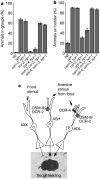Social feeding in Caenorhabditis elegans is induced by neurons that detect aversive stimuli
- PMID: 12410303
- PMCID: PMC3955269
- DOI: 10.1038/nature01169
Social feeding in Caenorhabditis elegans is induced by neurons that detect aversive stimuli
Abstract
Natural Caenorhabditis elegans isolates exhibit either social or solitary feeding on bacteria. We show here that social feeding is induced by nociceptive neurons that detect adverse or stressful conditions. Ablation of the nociceptive neurons ASH and ADL transforms social animals into solitary feeders. Social feeding is probably due to the sensation of noxious chemicals by ASH and ADL neurons; it requires the genes ocr-2 and osm-9, which encode TRP-related transduction channels, and odr-4 and odr-8, which are required to localize sensory chemoreceptors to cilia. Other sensory neurons may suppress social feeding, as social feeding in ocr-2 and odr-4 mutants is restored by mutations in osm-3, a gene required for the development of 26 ciliated sensory neurons. Our data suggest a model for regulation of social feeding by opposing sensory inputs: aversive inputs to nociceptive neurons promote social feeding, whereas antagonistic inputs from neurons that express osm-3 inhibit aggregation.
Figures





Comment in
-
Neurobiology: social eating for stress.Nature. 2002 Oct 31;419(6910):893-4. doi: 10.1038/419893a. Nature. 2002. PMID: 12410296 No abstract available.
References
-
- Wilson EO. Sociobiology. Belknap, Harvard Univ; Cambridge, Massachusetts: 1975.
-
- Choe JC, Crespi BJ. The Evolution of Social Behavior in Insects and Arachnids. Cambridge Univ. Press; Cambridge: 1997.
-
- Hassell MP, May RM. Stability in insect host-parasitoid models. J. Anim. Ecol. 1973;42:693–736.
-
- Shorrocks B, Sevenster JG. Explaining local species diversity. Proc. R. Soc. Lond. B. 1995;260:305–309. - PubMed
-
- McBride JM, Hollis JP. The phenomenon of swarming in nematodes. Nature. 1966;211:545–546. - PubMed
Publication types
MeSH terms
Substances
Grants and funding
LinkOut - more resources
Full Text Sources
Other Literature Sources
Research Materials
Miscellaneous

